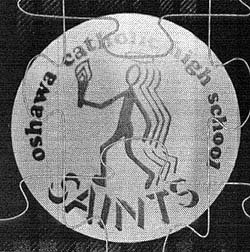 Sister Andrea Dumont, the longest-serving religious in Thompson by far when she retired back to Ontario in mid-June to live with other members of her order in a residence in Toronto, at the insistence of her general superior, has died at the age of 86.
Sister Andrea Dumont, the longest-serving religious in Thompson by far when she retired back to Ontario in mid-June to live with other members of her order in a residence in Toronto, at the insistence of her general superior, has died at the age of 86.
Originally from St. Catharines, Ontario. and a member of the Congregation of the Sisters of St. Joseph of Toronto, Sister Andrea arrived in Thompson in 1991 and spent 29 years working here.
Her parents, William Dumont and Orienne Gauthier, were from Quebec.
Sister Andrea graduated as a registered nurse from St. Joseph’s Hospital School of Nursing in Toronto in 1955. She worked as a nurse in Windsor and then at the emergency department and in the nursing service office at St. Joseph’s Hospital before seeing a notice from the sisters seeking volunteers for some missionary work, Thompson Citizen editor Ian Graham wrote May 28 in a nice piece on her impending retirement (https://www.thompsoncitizen.net/news/thompson/after-29-years-in-thompson-sister-andrea-dumont-returning-to-toronto-1.24143006).
Sister Andrea entered the Sisters of St. Joseph of Toronto in February 1956, and received the habit in August 1956. She made her final profession in August 1961 and celebrated her diamond jubilee in June 2016.
Sister Andrea spent 14 years in Guatemala until the mission closed and after returning to Canada lived in Grand Rapids, Easterville and Thompson, where the main focus of her work was in adult education, which included training lay presiders for times when there is no priest available, organizing and instructing in the various ministries, sacramental preparation and RCIA (Rite of Christian Initiation of Adults). There are no parochial Catholic schools in the area. As well as Guatemala, the Congregation of the Sisters of St. Joseph of Toronto at one time also had foreign missions in Hong Kong, Sierra Leone, Ghana, Nicaragua, Honduras and Haiti. They continue to serve in Honduras and Haiti.
In April 2015, she received the St. Joseph Award, the highest honour Catholic Missions in Canada bestows for outstanding missionary work. The Catholic Missions in Canada was founded in 1908 as The Catholic Church Extension Society of Canada. The organization comes to the aid of isolated missions across the country where a lack of resources makes it impossible to maintain a Catholic presence without outside financial help.
Sister Andrea’s order also included some of the same sisters – a fact I only learned here in Thompson years later – that taught some of my high school classes from September 1971 to June 1976, when Sister Conrad Lauber was principal, and Sister Dorothy Schweitzer taught me several English and math classes at Oshawa Catholic High School (now Monsignor Paul Dwyer Catholic High School). Both Sister Conrad and Sister Dorothy, so it turned out, happened to be good friends of Sister Andrea.
About 10 years ago, I asked Father Eugene Whyte, then pastor of St. Lawrence Church here in Thompson, and a member of the Missionary Oblates of Mary Immaculate, about the prospects of a particular sister soon retiring. Without missing a beat, Father Eugene’s deadpan reply was, “Nuns don’t really retire, John. Ever.”
I wasn’t quite sure then that was quite literally true, but pretty darn close, I thought as I caught Father Eugene’s drift.
For my Catholic friends, it will come as no surprise for me to say there are at least two other truths in addition to non-retirement about Catholic nuns, always worth remembering: you don’t want to incur their wrath and you can never say “no” to a request from a sister, which usually is stated more in the form of a direction assuming compliance, than an actual question. Such, of course, was the case in my relationship with Sister Andrea.
In November 2010, I had Ryan Flanagan, a new reporter at the Thompson Citizen, which I was editing at the time, write a story on charitable organizations who sold homemade goodies at community events as fundraisers for their many good works. One of his stops that crisp fall Saturday morning was the St. Lawrence Pastoral Centre, where Sister Andrea and other volunteers were making their famous perogies for the upcoming Catholic Women’s League (CWL) Annual Christmas craft sale and raffle, scheduled to be held a few short weeks at St.. Lawrence Parish Hall, and the premier fundraising event of the year for the CWL.
Sure enough, Ryan, would wind up writing, “Among the guidelines are that the event must be registered with Public Health at least 14 working days before it begins, that the event operator must maintain a list of all vendors including contact information, and that any food qualifying as ‘potentially hazardous’ must be prepared and packaged in an approved establishment. Foods qualifying as ‘potentially hazardous’ include antipasto, cabbage rolls, chocolate (unless it has been heated as an ingredient in, for example, chocolate chip cookies), coleslaw, pastries filled with cream or custard, dairy products, fish, garlic spreads, homemade soups, meat or meat products, perogies, pickled eggs, pumpkin pie or any pie with meringue, salsa, ungraded eggs, and whipped butter. None of these foods can be sold unless they were prepared in a facility that has been approved by the province as a food handling establishment” (https://www.thompsoncitizen.net/news/thompson/strict-public-health-rules-in-place-for-volunteer-groups-food-and-bake-sales-1.1368718).
I found myself in Sister Andrea’s “if-looks-could-kill” deep freeze for several months. The gradual thaw came a few months later, as Father Eugene made a point of being extra nice to me (no small feat perhaps, as Father Eugene’s opinion of the media wasn’t so very removed from Sister Andrea’s in general, as I recall, from our many conversations) when Sister Andrea and I were sharing the same space, such as reaching extra far to shake my hand when he was processing at the beginning of mass and I was standing near the end of a pew, perhaps suggesting to Sister Andrea that despite apparent evidence to the contrary, I might not be quite beyond redemption.
Sister Andrea, of course, forgave me in time, which is what sisters do. Within a couple of years she was swapping movie lists with Jeanette and I.
She may have also had the last laugh, as it were, a few years later, although she was also may have just been being practical and solving a problem on the fly on short notice. Or a little of both maybe.
In May 2013, The Christophers, a non-profit organization founded in 1945 by Maryknoll Father James Keller, were in Thompson to offer a Christopher leadership course. The ancient Chinese proverb – “it’s better to light one candle than to curse the darkness” – guides the organization’s programs. The name of the group is derived from the Greek word “christophoros,” which means “Christ-bearer.”
The Christopher leadership courses teaches participants speaking skills to organize ideas an think on their feet; conquer shyness or fear of public-speaking; speak with conviction and “captivate” their audience; and effectively express themselves in business, socially, in the community and in the larger world.
The New York City-based Christophers emerged in the wake of the Second World War, with the rapid dawn soon after of the Cold War, as periodic historical suspicions of Roman Catholic loyalties in the United States re-emerged in the public conspicuousness. In response, a number of Roman Catholics began to find new ways of commending the Church to the public, including the new medium of television. The most popular and influential television presentation was The Christophers, a weekly half-hour program aired on ABC beginning in 1945. The Christophers, as Keller, from Oakland, California envisioned it, would have no formal organization, no memberships, and no dues. “The reason for this somewhat unusual formula,” he explained, “was to focus attention on personal responsibility.”
The wrap-up to the Thompson Christopher leadership course seven years ago was to be held on Saturday, May 4, and was to feature a keynote speech from Archbishop Sylvain Lavoie, who had just recently become the most recent archbishop emeritus of the Roman Catholic Archdiocese of Keewatin-Le Pas. However, plans changed at the last minute, and His Grace was unable to keep the speaking engagement.
Sister Andrea telephoned me around mid-afternoon on Friday, May 3 in my office at the paper. And that was how I came to fill in with less than 24 hours notice for the archbishop – a sad disappointment I’m sure to unsuspecting participants – as the keynote speaker for the wrap-up session.
I’m not sure, but I could swear I saw a grin on Sister Andrea’s face, as I mercifully finished up, and heard from somewhere above me a good-natured celestial “got you.”
The last time I wrote about Sister Andrea until today was in an email I sent to Thompson Mayor Colleen Smook May 30:
“I was thinking about the departure of Sister Andrea next month back to Toronto, after being recalled at the age of 86, after 29 years in Thompson by her religious order, the Congregation of the Sisters of St. Joseph of Toronto, and it occurred to me that I could think of no one any worthier to receive a Key to the City of Thompson than Sister Andrea. I also know it is an infrequently bestowed honour, but having known several of the previous recipients over the last decade – Dr. Alan Rich, when he departed for Swan River in 2014, and provincial court Judge Murray Thompson, and his wife, Linda Webstob, when they moved to Winnipeg the same year – left me thinking Sister Andrea would be in good company with those keyholders of high character and purpose, and vice versa.”
I don’t know if the City of Thompson has ever awarded a Key to the City posthumously, but I think, if not, Sister Andrea would still be a good candidate for one, after touching so many lives, Catholic and non-Catholic, during her 29 years of service in Thompson, Manitoba.
You can also follow me on Twitter at: https://twitter.com/jwbarker22





































